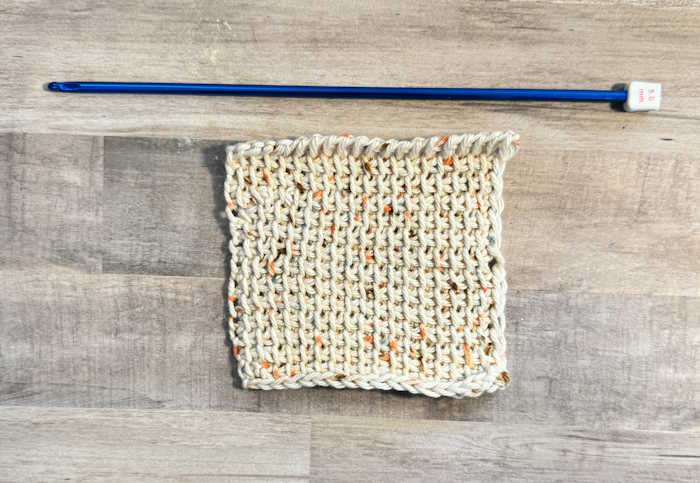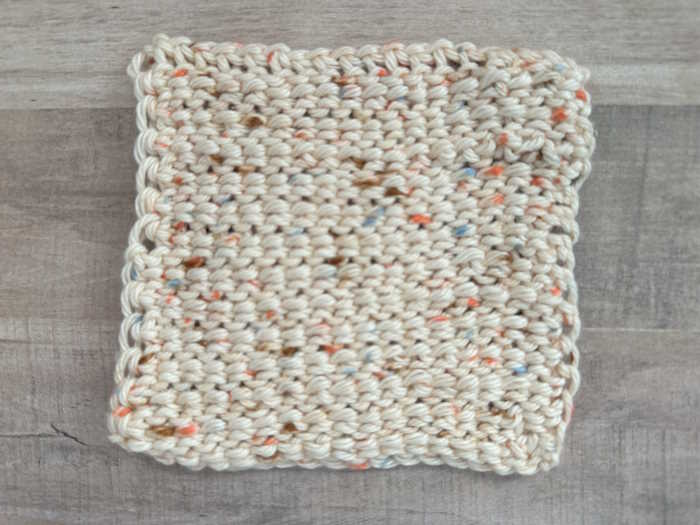- Home
- Crochet Stitches
- Tunisian Simple Stitch
Tunisian Simple Stitch: Beginner-friendly Introduction
Tunisian crochet, despite its name, didn't originate in Tunisia. Its roots are believed to lie in ancient Egypt, but this unique crochet style gained popularity throughout 19th-century Europe, particularly France. While often referred to as "crochet," Tunisian crochet truly blends elements of both knitting and crochet, creating a woven, tapestry-like fabric.
Unlike traditional crochet, which uses a single hook to create loops one at a time, Tunisian crochet employs a longer hook, often with a cable attached, to hold an entire row of loops at once. This technique results in a denser fabric with a distinctive vertical grain.

There are numerous Tunisian crochet stitches, each adding its flair to projects. However, the Tunisian Simple Stitch (TSS) is the foundation for all other stitches.
Why learn Tunisian Simple Stitch?
Unique Texture: Unlike regular crochet, this creates a beautifully textured fabric with a subtle knit-like appearance.
Dense and Warm Fabric: The tight weave makes it perfect for warm garments, blankets, and cozy accessories.
Not Reversible: This Tunisian stitch is not reversible, but the reverse stitch resembles the Knit garter stitch or the reverse Stockinette stitch.
Meditative and Fun: The rhythmic process of working the stitches can be pretty relaxing and enjoyable.
A Word on Tunisian Crochet Hooks
Before diving into the tutorial, let's talk about the tools of the trade. Tunisian crochet hooks differ from regular crochet hooks in a few key ways:
Length: Tunisian hooks are significantly longer to accommodate the multiple loops held during a row.
Cable: Many Tunisian hooks have a flexible cable attached to the end, allowing you to work on larger projects without the loops slipping off.
Double-Ended: Some Tunisian hooks are double-ended, featuring a hook on both ends, which can be helpful in specific techniques.
When choosing a Tunisian hook, consider the following:
Yarn Weight: Like regular crochet, select a hook size appropriate for your yarn weight.
Project Size: A shorter hook without a cable might suffice for smaller projects like coasters. A hook with a cable is essential for larger items like blankets.
Tunisian Simple Stitch Tutorial
Materials
Tunisian crochet hook (size to match your yarn)
Yarn of your choice
Tunisian Simple Stitch
 Right side of this stitch pattern
Right side of this stitch pattern This is what the Tunisian simple stitch looks like on the wrong side. For any knitters out there, you might think it resembles the wrong side of the stockinette stitch or even the garter stitch.
This is what the Tunisian simple stitch looks like on the wrong side. For any knitters out there, you might think it resembles the wrong side of the stockinette stitch or even the garter stitch.Let's Begin
We will be making two passes, the forward and return passes. In the forward pass, stitches are collected on the hook. In the return pass, stitches are worked off the hook, but first, you need to make a foundation chain.
Base Chain: Create a foundation chain with an even number of stitches, just like in regular crochet.
Tip
Making your foundation chain relatively loose is essential for easier hook insertion in subsequent rows.
Step 1: Forward Pass
Forward Pass (picking up loops):
Insert your hook under the second chain from the hook.
Yarn over and pull up a loop, keeping it on the hook.
*Insert your hook into the next chain, yarn over, and pull up a loop, keeping it on the hook. *
Repeat this process across the entire chain. You should now have all of the loops of the first row on your hook.
Tip
Don't worry if the loops on your hook seem stretched out. This is normal.
Step 2: Return Pass
Return Pass (working the loops off):
Yarn over and pull through one loop on your hook (this creates the edge stitch). Then,
*Yarn over and pull through two loops*. Repeat this step across the entire row until only one loop remains on your hook.
Tip
The return pass creates the fabric, so maintain consistent tension.
Step 3: Second Forward Pass
Second Forward Pass
Insert your hook behind the second vertical bars created in the previous row's return pass. Yarn over and pull up a loop, leaving it on the hook. *Insert your hook through the next bar, yarn over, and pull up a loop, keeping it on the hook. * Repeat this process to the end of the row.
Pick up one loop across each bar.
Step 4: Second Return Pass
Second Return Pass
Work the return pass as described in step 3.
Step 5 and Beyond
Continue repeating steps 3 & 4 to achieve your desired length!
Tip
Tunisian crochet tends to curl up, especially when working with simple stitches. Don't worry; this is normal and will block out. To help prevent excessive curling, add a border in a different stitch or with a larger hook.
Even though the Tunisian Simple Stitch (TSS) is relatively easy to learn, beginners often encounter a few common hurdles:
Casting Off/Binding Off
This is how you you finish the last row.
Insert your hook into the second vertical bar from the hook. Yarn Over and pull up a loop. Pull the same loop through the loop on the hook. *Insert hook in the next vertical bar, Yarn Over, and pull up a loop. Pull the same loop through the loop on the hook. Rep from * to end of row. Fasten off.
Tension Troubles
Too Tight: This is the most frequent issue. Beginners tend to pull the yarn too tightly, especially on the return pass, resulting in a stiff fabric that's difficult to work with and can even make the hook challenging to maneuver.
Uneven Tension: Inconsistent tension creates a wonky fabric, with some rows looser. This can distort the overall look of the project.
Stitch Confusion
Missing Stitches: Forgetting to pick up a loop during the forward pass will create gaps and an uneven edge.
Adding Extra Stitches:
Accidentally, picking up an extra loop (e.g., through the yarn between stitches) will add unwanted stitches to your row.
Working into the Wrong Space: It is essential to insert the hook into the correct space during the forward pass (under the vertical bars). Inserting the hook into the wrong place will lead to misplaced stitches and a messy appearance.
Curling Frustration
Curling Edges: TSS tends to curl inwards, especially on smaller pieces or with specific yarns. This can be frustrating for beginners used to traditional crochet, where blocking usually solves curling. Use a crochet hook at least one size larger than you normally would for your yarn, and keep your tension loose.
Experiment with different fibers. I love using cotton when working on the Tunisian simple stitch. Wool is another good choice because it is easy to block.
Other Challenges
Hand Fatigue: Holding multiple loops on the hook can lead to hand fatigue, especially with larger projects. Taking breaks and using ergonomic hooks can help. Holding the hook may be less of a problem if you know knitting. Holding the bare hook below the stitches helps me gain a little control.
Learning Curve: Tunisian crochet has a different rhythm and feel. It might take some time and practice to get comfortable with the technique.
Tips for Overcoming Challenges
Practice: Like any new skill, practice makes perfect. Start with small swatches to get a feel for the tension and rhythm before tackling larger projects.
Count Your Stitches: Regularly count your stitches to ensure you haven't missed or added any.
Use a Larger Hook: Especially when starting, using a hook one size larger than recommended for your yarn can help achieve looser tension.
Don't Give Up! Tunisian crochet is a rewarding craft. With patience and persistence, you'll create beautiful projects in no time.
What can you make with Tunisian Simple Stitch?
The possibilities are vast! The dense, reversible nature of TSS makes it ideal for:
Warm Garments: Sweaters, cardigans, scarves, hats, and even mittens.
Cozy Homewares: Blankets, throws, pillows, placemats, and coasters.
Fashionable Accessories: Bags, purses, phone cases, and jewelry.
Conclusion:
The Tunisian Simple Stitch is a gateway to a world of unique and beautiful crochet projects. It's easy to learn, relaxing to work, and yields stunning results. So grab your Tunisian hook and explore the captivating world of Tunisian crochet! Don't be afraid to experiment and have fun with it!










